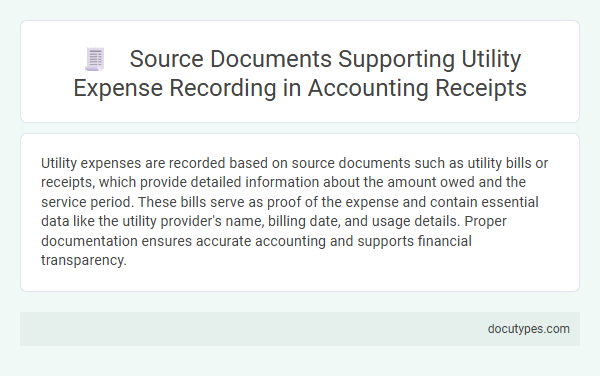Utility expenses are recorded based on source documents such as utility bills or receipts, which provide detailed information about the amount owed and the service period. These bills serve as proof of the expense and contain essential data like the utility provider's name, billing date, and usage details. Proper documentation ensures accurate accounting and supports financial transparency.
Importance of Source Documents in Utility Expense Recording
| Source Document | Description | Role in Recording Utility Expenses |
|---|---|---|
| Utility Bill | Official statement from utility providers (electricity, water, gas) indicating consumption and charges | Primary evidence supporting the recognition of utility expenses; ensures accurate and verifiable financial records |
| Receipt | Proof of payment issued upon settling utility bills | Confirms transaction completion, validity of expense, and supports audit trails |
| Payment Voucher | Internal document authorizing payment of utility expenses | Serves as control mechanism ensuring proper approval before payment is processed |
| Bank Statement | Record of financial transactions showing payments to utility providers | Reconciles cash outflows with recorded utility expenses, enhancing accuracy and transparency |
Importance of Source Documents in Utility Expense Recording
Source documents provide verifiable evidence for recording utility expenses, improving financial accuracy. They support compliance with accounting standards and facilitate audits by maintaining traceability of transactions. Proper documentation reduces errors and fraud risks while enhancing transparency. Using authentic utility bills, receipts, and related vouchers ensures reliability in financial reporting and budget management.
Types of Source Documents for Utility Expenses
Utility expenses are recorded based on source documents that verify the amount and date of the expense. Common types of source documents for utility expenses include utility bills, invoices from service providers, and payment receipts. These documents provide essential proof for accurate accounting and financial reporting of utility costs.
Key Details in Utility Receipts for Accounting
Utility receipts serve as the primary source document supporting the recording of utility expenses in accounting. These receipts provide essential information to verify and document the payment of utility services for accurate financial reporting.
- Payment Date - Indicates the exact date the utility expense was paid, ensuring timely recording in the accounting period.
- Amount Paid - Displays the total cost of the utility service, crucial for precise expense recognition and budget tracking.
- Service Description - Details the type of utility provided, such as electricity, water, or gas, helping to categorize expenses correctly.
Role of Utility Bills in Expense Verification
Utility bills serve as the primary source document supporting the recording of utility expenses. These bills provide detailed information on consumption, rates, and total charges, ensuring accurate expense entries.
Your utility bill plays a crucial role in expense verification by offering a reliable record of the amounts owed and paid. It helps validate the accuracy of recorded utility expenses during financial audits and budgeting processes.
Common Utility Service Providers and Document Formats
Utility expenses are recorded using source documents that detail the charges from service providers like electricity, water, and gas companies. Common utility service providers include Con Edison, PG&E, and American Water, each issuing bills that serve as primary records.
These bills typically come in formats such as paper statements, PDF invoices, or electronic billing statements accessed via online portals. Your business should retain these documents to ensure accurate accounting and facilitate audit processes. Maintaining clear records from these utility providers supports precise expense tracking and financial reporting.
Matching Utility Receipts with Payment Records
Utility receipts serve as the primary source documents supporting the recording of utility expenses. Matching these receipts with corresponding payment records ensures accuracy in financial reporting and expense verification.
- Utility Receipt - Documents the amount billed by the utility provider for services rendered during a specific period.
- Payment Record - Confirms the actual payment made to the utility company, indicating date and amount paid.
- Matching Process - Involves cross-verifying the utility receipts with payment records to confirm that recorded expenses align with payments made, aiding in error detection and audit compliance.
Best Practices for Storing Utility Source Documents
What source document supports the recording of utility expenses? Utility bills serve as the primary source documents for verifying and recording utility expenses accurately. Best practices for storing utility source documents include organizing them by date and vendor in a secure, accessible digital or physical filing system to ensure easy retrieval and audit compliance.
Documenting Digital Utility Receipts in Accounting
Digital utility receipts serve as crucial source documents for recording utility expenses in accounting. Proper documentation of these digital receipts ensures accurate financial tracking and compliance.
- Digital Utility Receipts - Provide detailed transaction data including date, amount, and service provider, essential for verifying expenses.
- Electronic Payment Confirmations - Confirm the successful payment of utility bills and validate recorded expenses.
- Online Account Statements - Offer comprehensive summaries of utility usage and charges, supporting accurate expense recording.
Maintaining organized digital utility receipts enhances transparency and facilitates audit processes in accounting.
Audit Compliance and Utility Expense Source Documents
Utility expense source documents, such as utility bills and invoices, provide essential evidence for recording utility expenses accurately. These documents serve as primary support during audits to ensure compliance with financial regulations.
Maintaining organized utility expense records helps verify the authenticity of transactions and supports audit trails. You must retain copies of these source documents to meet audit compliance requirements and validate utility expense entries.
What Source Document Supports the Recording of Utility Expenses? Infographic

